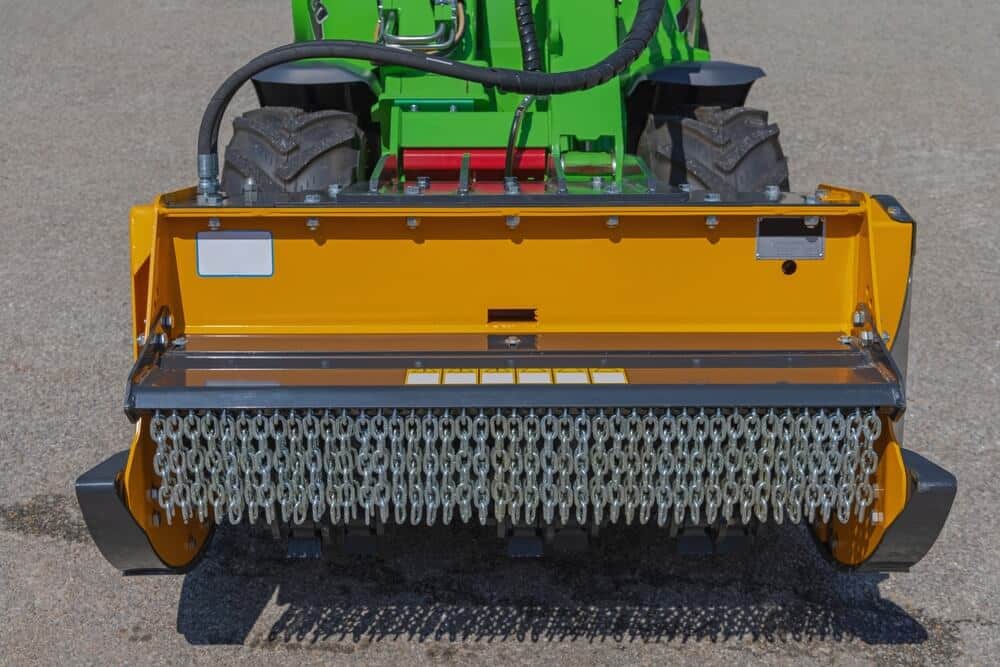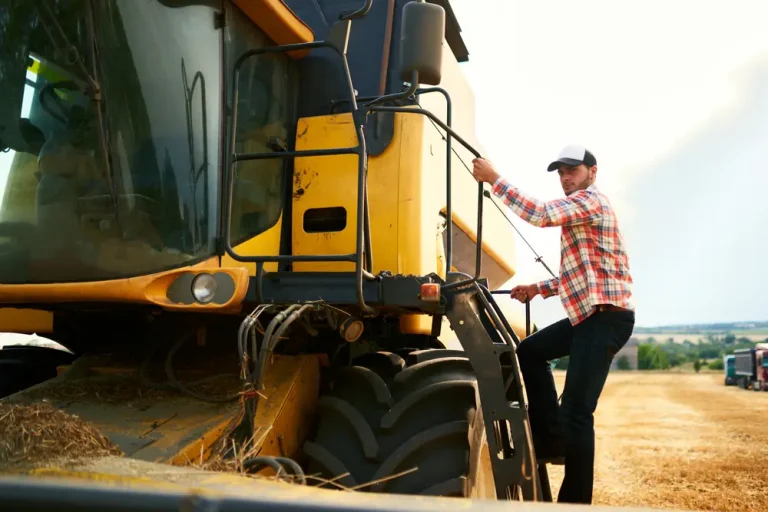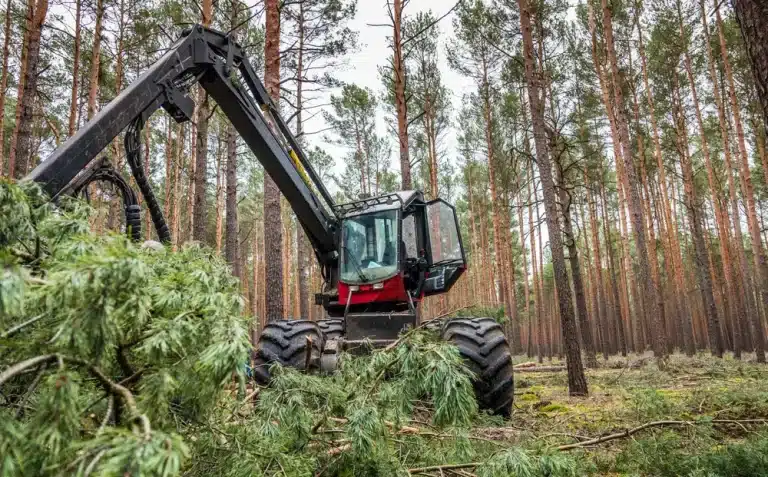Skid steer mulchers and spider excavator mulchers are built for different terrains, operators, and job intensities. Choosing between them depends on the scope of your project, the type of vegetation, and the ground conditions. Across steep slopes, flat lands, disaster recovery zones, or remote forestry sites, both types of equipment bring specific advantages and limits. This page compares their strengths and constraints so you can decide which tool makes more sense for your land clearing goals.
Terrain control and machine mobility
Terrain type determines the performance and safety of mulching operations. Whether clearing roadside vegetation or stabilizing steep slopes, your choice between a skid steer mulcher and a spider excavator mulcher influences how well you can navigate the land, especially under pressure.
Getting the right equipment in place before work begins avoids costly downtime and minimizes physical strain on both the machine and the operator.
How skid steer mulchers move on stable ground
Skid steer mulchers stand out for their compact size and agility, making them especially effective on stable, level terrain. Their design focuses on maneuverability in tight or confined spaces, which is why they excel around buildings, residential lots, and urban environments where space is limited.
The agility of skid steers allows operators to perform precise movements, enabling clean and controlled mulching along roadsides, parks, and small wooded areas.
Key advantages:
- Quick access and setup on flat terrain
- Easy maneuvering in tight or urban zones
- Compatible with multiple attachments
Beyond maneuverability, the quick attachment system on skid steers ensures rapid switching between tools, which is a significant time saver on jobs requiring diverse equipment.
This versatility makes them a preferred choice for contractors who manage a broad spectrum of small to medium-scale land clearing tasks, delivering consistent results without sacrificing speed or efficiency.
Discover how to optimize mulcher performance on skid steer machines
How spider excavators adapt to unstable terrain
Spider excavator mulchers are engineered to tackle some of the toughest environments where traditional machines struggle. Their defining feature is the articulated legs, which allow these machines to adjust dynamically to uneven and unstable ground, such as steep slopes, rocky embankments, and riverbanks.
This adaptive capability grants spider excavators an extraordinary level of stability and traction, preventing slips and rollovers in places where wheeled or tracked vehicles might become immobilized or unsafe.
The design supports safe navigation over challenging landscapes, enabling operators to reach otherwise inaccessible areas without compromising control or safety.
This makes spider excavators indispensable for forestry operations, wildfire prevention, and disaster recovery work in rugged, remote, or highly variable terrain, where reliability under pressure is non-negotiable.
Combining both machines for mixed jobsites
In many real-world projects, terrain and vegetation conditions vary significantly within the same worksite, making it impractical to rely solely on one type of machine.
Project managers who face diverse environments often benefit from deploying both skid steer mulchers and spider excavator mulchers, optimizing each machine’s strengths according to specific zones.
Skid steers handle accessible, flatter sections with speed and efficiency, while spider excavators cover the challenging slopes and unstable areas that require specialized mobility and stability.
This combined approach maximizes overall productivity and safety, reducing downtime caused by unsuitable equipment use. Contractors can also better manage operational costs by allocating tasks to the appropriate machinery.
Comparative overview of skid steer vs spider excavator mulchers
| Criteria | Skid steer mulcher | Spider excavator mulcher |
| Mobility | Good on flat or slightly uneven terrain | Excellent in steep, rocky, or irregular terrain |
| Terrain | Best for accessible and stable ground | Designed for extreme slopes / rough landscapes |
| Capacity | Medium power and reach | High power, extended reach, large attachments |
| Budget | Lower upfront and maintenance costs | Higher cost, more complex components |
| Maintenance | Simple daily upkeep | Requires more technical inspection and care |
Mulching speed and capacity on different terrains

Clearing efficiency is more than speed, it involves how well a machine handles brush density, surface conditions, and long shifts on-site. Comparing the daily output of a skid steer versus a spider excavator helps contractors predict timelines and quote more accurately. Both options can be adapted to different field conditions but deliver contrasting results depending on the landscape.
Speed and clearing range for skid steers
Productivity with skid steer mulchers is closely tied to their size and engine power, which makes them ideal for handling light to moderate vegetation quickly. These machines excel in clearing undergrowth, young saplings, and invasive species that typically grow in residential neighborhoods, municipal parks, or roadside verges. Their compact design and efficient mulcher attachments allow operators to maintain a fast pace on flat or gently sloping terrain, significantly reducing job duration.
This speed and versatility make skid steers the go-to choice for contractors tasked with routine maintenance or small-scale land clearing projects where swift turnaround is essential.
Additionally, skid steers can navigate tight spaces where larger machines cannot, making them highly effective in urban or semi-urban environments.
Depth and endurance for spider machines
Spider excavators bring superior power and endurance to land clearing, thanks to their ability to operate with heavier and larger mulcher attachments.
This capability allows them to handle thick trees, dense brush, and extensive surface areas that skid steers would struggle with. Their design supports prolonged operation in demanding conditions without compromising stability or operator safety. In wildfire prevention efforts, for example, spider machines can perform deep ground preparation to remove combustible material, effectively reducing fuel loads and minimizing fire risk.
Their long reach and durable construction also enable sustained work over uneven terrain, making them essential for large-scale forestry projects and hazardous cleanup operations where both power and precision are critical.
Ideal uses for high-output jobs:
- Post-fire fuel reduction on steep terrain
- Long shifts with heavy vegetation
- Remote or off-road land clearing
Maintenance matters
Proper maintenance is fundamental to ensuring your mulching equipment performs efficiently and lasts longer.
Regular inspections, timely replacement of wear parts, and routine cleaning prevent unexpected breakdowns and costly downtime.
Both skid steer and spider excavators require specific care tailored to their mechanics and usage conditions, from hydraulic systems to mulcher heads.
Operators and maintenance teams must stay vigilant about wear indicators and follow manufacturer guidelines to optimize machine lifespan.
To help you keep your forestry mulcher in top condition, we offer a comprehensive guide on how to maintain your forestry mulcher for long-term performance. This resource covers practical tips and checklists that reduce repair costs and improve operational reliability.
Which mulcher to choose based on project scale
The scale of your land clearing job often determines the type of equipment you should choose. Smaller, urban-based projects benefit from lighter machines, while expansive or technically challenging worksites demand robust and adaptable tools. Planning for operational scale means assessing both present needs and future workload.
Skid steers for short-term missions
Skid steers are often the preferred choice for short-term projects or rental jobs due to their accessibility and cost-effectiveness.
Their widespread availability makes them easy to source quickly, which is crucial when timelines are tight. Renting a skid steer usually involves lower upfront costs compared to more specialized equipment, enabling contractors and land managers to optimize their budgets without sacrificing efficiency.
Thanks to their compact dimensions, skid steers are easier to transport, requiring less space on trucks and reducing logistical complications. This portability also means they can be rapidly deployed to various job sites.
Furthermore, skid steers integrate seamlessly into mixed fleets, often working alongside mini-excavators or dump trucks, enhancing overall project coordination and productivity on smaller, less complex jobs.
Spider excavators for complex operations
Spider excavator mulchers represent a significant investment that goes beyond the initial purchase price.
Their specialized design demands careful planning for transport, as their articulated legs and bulkier attachments require more space and setup time. Operators also need targeted training to harness the full capabilities of these machines safely and efficiently, making the learning curve steeper.
Despite these challenges, spider excavators offer unparalleled performance for large-scale and technically demanding projects such as land reclamation, steep slope stabilization, or disaster recovery.
They thrive in difficult environments like mountainous terrains or flood-affected zones, where their adaptability and power ensure safe and effective removal of debris and vegetation.
For teams regularly facing these tough conditions, the spider excavator is a long-term asset that can improve both safety and operational outcomes.
Large-scale cleanup strategies
When dealing with extensive or high-risk land clearing, the choice of equipment can make or break the project’s success. Large-scale cleanup efforts, especially after natural disasters, require machines that combine power, durability, and precision to handle unpredictable terrain and heavy debris loads. Spider excavators and skid steers each play a vital role in these scenarios, depending on the specific demands of the site.
Read more in our article about the best mulching tools for post-disaster cleanups. This resource can help project managers optimize their approach and ensure safety and efficiency when responding to critical land management needs.
Attachment options and vegetation type
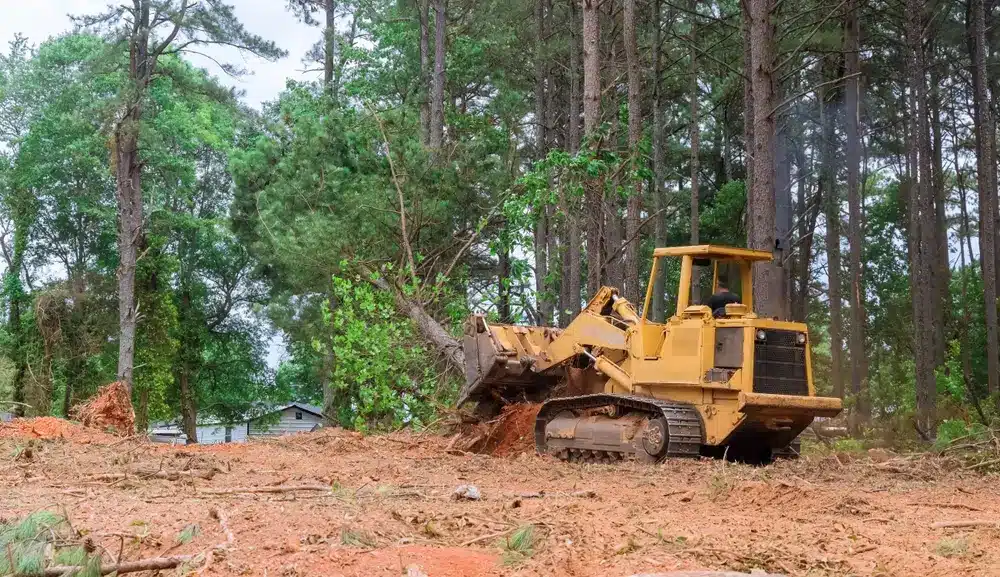
Each machine’s potential grows with the right attachment. Choosing the correct mulcher head helps reduce operating time and protect native vegetation. When equipment is matched to the landscape, productivity improves and vegetation regrowth is better managed. Knowing the brush types in your target area is crucial before starting.
Matching the right head to your machine
The effectiveness of your mulching operation hinges on pairing the appropriate mulcher head with your machine.
Skid steer mulchers benefit from a versatile range of attachments designed specifically for small to medium-sized brushes. These heads are typically lighter, allowing the machine to maintain agility and speed while clearing shrubs, saplings, and invasive plants efficiently.
On the other hand, spider excavators support larger, more robust mulcher heads engineered to tackle dense, woody vegetation and larger diameter trees.
These heavy-duty attachments enable spider machines to handle tougher jobs that require deep cutting and grinding power, especially in challenging terrain.
Selecting the right mulcher head ensures optimal cutting performance, reduces wear on your machine, and helps protect surrounding vegetation by minimizing unnecessary disturbance.
Typical vegetation for each machine
Understanding the types of vegetation best suited to each mulcher type improves operational efficiency and project outcomes.
Skid steer mulchers excel in managing light brush, scattered bushes, and saplings, making them ideal for clearing overgrown trails, roadside vegetation, and invasive species in open fields. Their maneuverability and smaller attachment size allow for precise work without overstraining the machine or operator.
Conversely, spider mulchers are built to perform under more demanding conditions, excelling on steep or unstable terrain where heavy, dense vegetation is common.
These machines are particularly effective in emergency response zones where access is limited due to fallen trees or debris, as well as in large-scale forestry operations and slope stabilization projects that require substantial cutting power and stability.
- Skid steer mulchers work best on:
- Light brush, bushes, and saplings
- Invasive plant species in open fields
- Trail maintenance near public roads
- Spider mulchers perform well on:
- Steep or unstable terrain with heavy vegetation
- Emergency zones with blocked access
- Large-scale forestry and slope stabilization
Know your vegetation
Choosing the right machine and attachments starts with a clear understanding of the vegetation you’ll be managing. Different species, plant densities, and terrain conditions require tailored approaches to ensure safety, efficiency, and ecological sensitivity.
Deepen your knowledge of the vegetation types that various mulchers can handle and optimize your equipment choice accordingly, explore our detailed guide what types of vegetation can a mulcher handle?. This resource will help you plan your land clearing strategy with confidence and maximize the performance of your mulching equipment.
Cost, ownership and long-term strategy
Financial planning affects whether you rent or invest in a machine.
Evaluating the full cost of ownership, including maintenance, transport, and operator training, gives clarity on which path fits your business model.
Long-term projects in complex terrain justify different financial choices than short seasonal jobs.
Entry-level costs and rental benefits
For many contractors and land management teams, the upfront investment is a critical factor when choosing equipment.
Skid steers offer a significantly lower entry cost, whether you’re considering purchasing or renting.
Their simpler design translates into easier maintenance and quicker repairs, supported by widespread availability of parts and skilled operators.
This affordability makes skid steers especially attractive for contractors handling multiple short-term projects or seasonal work, where flexibility and low overhead are essential.
Additionally, rental options for skid steers are common and competitively priced, allowing businesses to scale their capacity without committing to a full purchase.
This financial accessibility reduces risk while enabling quick deployment to meet tight project schedules.
Why choose a skid steer for cost control:
- Lower purchase and rental price
- Faster return on investment
- Simpler operator training
Long-term value for specialized teams
Spider excavators represent a more substantial initial investment, often requiring trained operators and dedicated transport arrangements.
Despite these higher costs, their value becomes clear for teams engaged in specialized or large-scale operations. When deployed consistently in challenging environments such as steep slopes, remote forestry areas, or disaster recovery sites, spider excavators deliver exceptional durability and performance.
Their advanced capabilities and rugged build reduce downtime and extend operational lifespan, making them a smart long-term asset for companies focused on complex land management.
Over time, the higher upfront costs are balanced by increased productivity, safety, and reduced replacement frequency, especially for teams with ongoing or recurring specialized needs.
Cost strategy by project type
Deciding whether to rent or buy, and which type of machine to select, depends heavily on the scope and duration of your projects. Shorter, less complex jobs may benefit from the cost-effectiveness and flexibility of renting skid steers, while long-term, high-intensity projects often justify the investment in spider excavators.
Crafting a cost strategy tailored to your operational needs ensures you balance efficiency, budget, and equipment availability.
For a detailed comparison and guidance on making the best financial decision for your land clearing needs, consult our comprehensive article renting vs buying a mulcher: what’s best for your project?. We listed all the benefits of ownership against rental options based on project size, terrain, and long-term goals.
Eco-friendly mulching: reduce soil disturbance and erosion
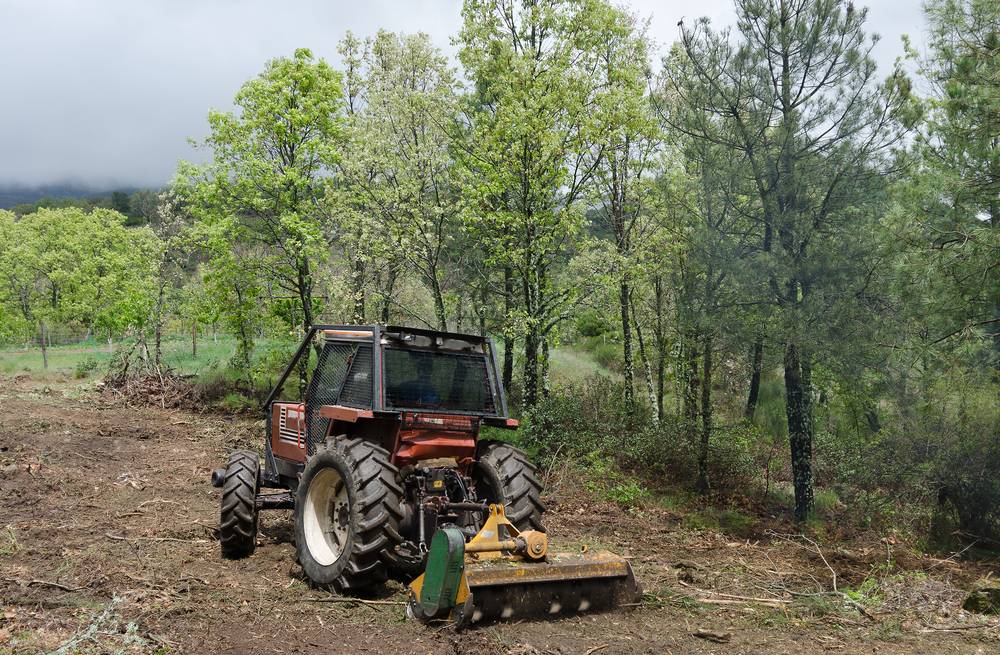
As land use regulations become stricter, equipment choices must align with sustainability standards. Machines that can reduce soil disturbance or operate in sensitive zones offer more than just power, they contribute to long-term ecological balance. Understanding the environmental cost of your operations is as important as job performance.
Light footprint of skid steers
Skid steers are well-suited for projects where minimizing environmental impact is a priority.
Their compact size and lightweight design reduce soil compaction, which is crucial when working near sensitive ecological zones, agricultural fields, or protected habitats. Because they put less pressure on the ground compared to larger machines, skid steers help preserve soil structure and reduce erosion risks.
Their agility also allows operators to maneuver carefully around delicate vegetation and terrain features, avoiding unnecessary damage. For land managers focused on maintaining ecological balance while completing efficient clearing tasks, skid steers offer a practical solution that aligns with sustainable land use principles.
Precision and control with spider machines
Spider excavators excel in projects requiring exceptional precision and adaptability, especially in sensitive or complex environments. Their articulated legs provide unmatched stability and allow for controlled, deliberate movements that minimize disruption to fragile ecosystems. This makes them particularly valuable in reforestation efforts, erosion control, and other conservation-focused operations. By carefully navigating steep slopes, rocky outcrops, or uneven terrain, spider machines help preserve root systems and native plants, supporting healthier regrowth.
In this article the role of mulchers in sustainable land management, we explore how these machines contribute to long-term ecological goals by balancing operational effectiveness with environmental stewardship.
Operator safety and performance in rough terrain
Operator protection is essential when working in unpredictable environments. From basic stability to advanced safety systems, each machine has built-in strengths.
Choosing the right platform means fewer accidents, better control, and longer equipment life. Adapted training and ground assessment further reduce hazards during demanding jobs.
Skid steer safety in regular zones
Safety is a fundamental concern when operating any heavy machinery, and skid steers are designed to meet this need in stable and predictable environments.
Their secure enclosed cabs protect operators from debris, dust, and weather conditions while providing excellent visibility of the surrounding jobsite.
This broad field of view helps operators navigate tight spaces, avoid obstacles, and work efficiently without risking collisions.
Because skid steers operate primarily on firm, level terrain, they offer stable handling that makes them manageable even for operators with basic training.
This balance of safety features and ease of use makes skid steers a reliable choice for many standard land clearing and maintenance tasks.
Spider mulchers in dangerous conditions
Spider excavators are engineered to operate safely in the most challenging and unstable terrains, where traditional machinery struggles.
Their unique design includes adjustable limbs and a low center of gravity, significantly reducing the risk of rollovers even on steep slopes or uneven ground.
This stability is critical for teams working in wildfire zones, landslide areas, or flood-affected regions where ground conditions are unpredictable and dangerous.
Spider mulchers allow operators to reach difficult or hazardous spots without compromising safety, giving crews the confidence to perform high-risk jobs with greater control and security.
Their advanced features make them indispensable tools for disaster response and other complex land management situations.
Stay safe with every machine
Regardless of the equipment you choose, maintaining safety protocols is essential to protect your crew and maximize operational efficiency. For comprehensive advice on best practices, consult our guide safety tips when operating a mulcher in tough terrain.
We got you covered with everything from pre-operation checks to safe maneuvering techniques tailored to both skid steers and spider mulchers, helping your team stay safe across diverse working conditions.
“The right equipment doesn’t just get the job done, it shapes how safely and efficiently the work unfolds on every inch of the land.”
Quick decision guide
Which machine for which job?
Use a skid steer mulcher if you’re working on:
▪ flat land or light slopes
▪ mid-sized clearing tasks
▪ tighter access areas
▪ a limited budget
Choose a spider excavator mulcher if your job involves:
▪ steep hills, rocky ground, or wetlands
▪ hard-to-reach vegetation
▪ long sessions on challenging terrain
▪ the need for maximum power and reach
